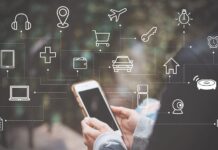The Internet of Things (IoT) is a network of connected devices that communicate with each other and with the internet. These devices can range from smartphones and wearables to household appliances and industrial equipment. The IoT is transforming the way we live and work by enabling us to collect and analyze data in real-time, automate tasks, and improve efficiency. In this article, we will explore the IoT and how connected devices are changing our lives.
What is the Internet of Things?
The Internet of Things is a network of connected devices that communicate with each other and with the internet. These devices can range from smartphones and wearables to household appliances and industrial equipment. The IoT enables devices to collect and share data in real-time, allowing us to monitor and control our environments in new ways.
How the Internet of Things Works
The Internet of Things works by connecting devices to the internet and to each other through a network of sensors, communication devices, and software. These devices can collect data, communicate with other devices, and respond to commands or triggers.
For example, a smart thermostat in a home can use sensors to detect the temperature and humidity levels in a room. It can then communicate with other devices, such as an air conditioning unit, to adjust the temperature and humidity levels in the room. The smart thermostat can also be controlled remotely through a smartphone app, allowing homeowners to adjust the temperature from anywhere.
Applications of the Internet of Things
The Internet of Things has a wide range of applications, from healthcare to manufacturing to transportation. Here are some examples of how the IoT is being used in various industries:
-
Healthcare
The IoT is being used in healthcare to monitor patient health, improve patient outcomes, and reduce costs. Wearable devices, such as fitness trackers and smartwatches, can monitor vital signs, such as heart rate and blood pressure, and provide real-time feedback to patients and healthcare providers.
-
Manufacturing
The IoT is being used in manufacturing to improve efficiency, reduce costs, and increase productivity. Connected sensors can monitor equipment and production processes, providing real-time data that can be used to optimize operations and reduce downtime.
-
Transportation
The IoT is being used in transportation to improve safety, reduce congestion, and increase efficiency. Connected vehicles can communicate with each other and with infrastructure, such as traffic lights and road sensors, to optimize traffic flow and reduce the risk of accidents.
-
Smart Homes
The IoT is being used in smart homes to improve comfort, convenience, and energy efficiency. Connected devices, such as smart thermostats and smart lighting, can be controlled remotely through a smartphone app, allowing homeowners to adjust their home environment from anywhere.
Challenges and Opportunities for the Internet of Things
While the Internet of Things presents many opportunities, there are also challenges that come with the adoption of connected devices. Here are some of the challenges and opportunities for the IoT:
-
Security
Security is a major concern when it comes to the Internet of Things. Connected devices can be vulnerable to hacking and cyberattacks, potentially putting personal information and safety at risk.
-
Interoperability
Interoperability is a challenge for the Internet of Things, as different devices and platforms may not be compatible with each other. This can limit the potential of the IoT to create a unified and interoperable system for connected devices.
-
Privacy
Privacy is also a concern when it comes to the Internet of Things. Connected devices can collect personal information, potentially putting privacy at risk.
-
Innovation
However, the Internet of Things also presents many opportunities for innovation and progress. By connecting devices and collecting data in real-time, the IoT can improve efficiency, reduce costs, and drive innovation in a wide range of industries.
-
Sustainability
The Internet of Things also has the potential to contribute to sustainability by enabling more efficient use of resources. Connected devices can help to reduce energy consumption, optimize transportation, and improve waste management.
Future of the Internet of Things
The Internet of Things is still in its early stages, and there is much room for growth and innovation. Here are some of the trends that are likely to shape the future of the IoT:
-
Artificial Intelligence
Artificial intelligence (AI) is a key component of the Internet of Things. Advances in AI are enabling devices to learn and adapt in real-time, improving their ability to perform tasks and respond to changing environments.
-
Edge Computing
Edge computing is another trend that is likely to shape the future of the Internet of Things. Edge computing involves processing data on the device itself, rather than sending it to a central server for processing. This can improve the speed and efficiency of data processing, while also reducing the risk of data breaches and cyberattacks.
-
5G Networks
5G networks are a key enabler of the Internet of Things. 5G networks provide faster speeds and lower latency, enabling more devices to be connected and improving the quality of data transmission.
-
Smart Cities
Smart cities are another area of development in the Internet of Things. Smart cities use connected devices and data analytics to improve city services, such as transportation, energy, and waste management.
Conclusion
The Internet of Things is transforming the way we live and work by enabling us to collect and analyze data in real-time, automate tasks, and improve efficiency. While there are challenges and concerns to be addressed, the potential benefits of the IoT are significant, and it is important to continue to invest in the development and deployment of connected devices in a responsible and ethical manner.
As the technology continues to evolve, there will be a growing need for ethical and governance frameworks to ensure that connected devices are used in a safe and responsible way. Collaboration between industry, government, and society will be essential to ensure that the benefits of the Internet of Things are realized while minimizing potential risks and ethical concerns.
Overall, the Internet of Things presents an exciting opportunity for innovation and progress in many industries. While there are challenges and concerns to be addressed, the potential benefits of connected devices are significant, and it is important to continue to invest in the development and deployment of the IoT in a responsible and ethical manner.
Google News | Telegram
















